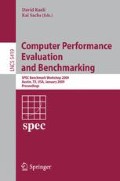Abstract
The contentious debates between RISC and CISC have died down, and a CISC ISA, the x86 continues to be popular. Nowadays, processors with CISC-ISAs translate the CISC instructions into RISC style micro-operations (eg: uops of Intel and ROPS of AMD). The use of the uops (or ROPS) allows the use of RISC-style execution cores, and use of various micro-architectural techniques that can be easily implemented in RISC cores. This can easily allow CISC processors to approach RISC performance. However, CISC ISAs do have the additional burden of translating instructions to micro-operations. In a 1991 study between VAX and MIPS, Bhandarkar and Clark showed that after canceling out the code size advantage of CISC and the CPI advantage of RISC, the MIPS processor had an average 2.7x advantage over the studied CISC processor (VAX). A 1997 study on Alpha 21064 and the Intel Pentium Pro still showed 5% to 200% advantage for RISC for various SPEC CPU95 programs. A decade later and after introduction of interesting techniques such as fusion of micro-operations in the x86, we set off to compare a recent RISC and a recent CISC processor, the IBM POWER5+ and the Intel Woodcrest. We find that the SPEC CPU2006 programs are divided between those showing an advantage on POWER5+ or Woodcrest, narrowing down the 2.7x advantage to nearly 1.0. Our study points to the fact that if aggressive micro-architectural techniques for ILP and high performance can be carefully applied, a CISC ISA can be implemented to yield similar performance as RISC processors. Another interesting observation is that approximately 40% of all work done on the Woodcrest is wasteful execution in the mispredicted path.
Access this chapter
Tax calculation will be finalised at checkout
Purchases are for personal use only
Preview
Unable to display preview. Download preview PDF.
References
Agerwala, T., Cocke, J.: High-performance reduced instruction set processors. Technical report, IBM Computer Science (1987)
Bekerman, M., Yoaz, A., Gabbay, F., Jourdan, S., Kalaev, M., Ronen, R.: Early load address resolution via register tracking. In: Proceedings of the 27th Annual international Symposium on Computer Architecture, pp. 306–315
Bhandarkar, D., Clark, D.W.: Performance from architecture: comparing a RISC and a CISC with similar hardware organization. In: Proceedings of ASPLOS 1991, pp. 310–319 (1991)
Bhandarkar, D.: A Tale of two Chips. ACM SIGARCH Computer Architecture News 25(1), 1–12 (1997)
Bhandarkar, D., Ding, J.: Performance Characterization of the Pentium® Pro Processor. In: Proceedings of the 3rd IEEE Symposium on High Performance Computer Architecture, February 01-05, 1997, pp. 288–297 (1997)
Chow, F., Correll, S., Himelstein, M., Killian, E., Weber, L.: How many addressing modes are enough. In: Proceedings of ASPLOS-2, pp. 117–121 (1987)
Cmelik, et al.: An analysis of MIPS and SPARC instruction set utilization on the SPEC benchmarks. In: ASPLOS 1991, pp. 290–302 (1991)
Hennessy, Gelsinger Debate: Can the 386 Architecture Keep Up? John Hennessy and Pat Gelsinger Debate the Future of RISC vs. CISC: Microprocessor Report
Hennessy, J.: VLSI Processor Architecture. IEEE Transactions on Computers C-33(11), 1221–1246 (1984)
Hennessy, J.: VLSI RISC Processors. VLSI Systems Design, VI:10, pp. 22–32 (October 1985)
Inside Intel Core Microarchitecture: Setting New Standards for Energy-Efficient Performance, http://www.intel.com/technology/architecture-silicon/core/
Smith, J.E., Weiss, S.: PowerPC 601 and Alpha 21064. A Tale of Two RISCs, IEEE Computer
Microprocessor Report – Chart Watch - Server Processors. Data as of (October 2007) http://www.mdronline.com/mpr/cw/cw_wks.html
Patterson, D.A., Ditzel, D.R.: The case for the reduced instruction set computer. Computer architecture News 8(6), 25–33 (1980)
Patterson, D.: Reduced Instruction Set Computers. Communications of the ACM 28(1), 8–21 (1985)
Kanter, D.: Fall Processor Forum 2006: IBM’s POWER6, http://www.realworldtech.com/
Kanter, D.: Intel’s Next Generation Microarchitecture Unveiled. Real World Technologies (March 2006), http://www.realworldtech.com
SPEC Benchmarks, http://www.spec.org
Wong, M.: C++ benchmarks in SPEC CPU 2006. SIGARCH Computer Architecture News 35(1), 77–83 (2007)
Author information
Authors and Affiliations
Editor information
Editors and Affiliations
Rights and permissions
Copyright information
© 2009 Springer-Verlag Berlin Heidelberg
About this paper
Cite this paper
Isen, C., John, L.K., John, E. (2009). A Tale of Two Processors: Revisiting the RISC-CISC Debate. In: Kaeli, D., Sachs, K. (eds) Computer Performance Evaluation and Benchmarking. SBW 2009. Lecture Notes in Computer Science, vol 5419. Springer, Berlin, Heidelberg. https://doi.org/10.1007/978-3-540-93799-9_4
Download citation
DOI: https://doi.org/10.1007/978-3-540-93799-9_4
Publisher Name: Springer, Berlin, Heidelberg
Print ISBN: 978-3-540-93798-2
Online ISBN: 978-3-540-93799-9
eBook Packages: Computer ScienceComputer Science (R0)

